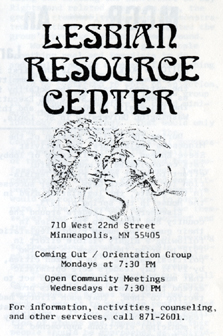Difference between revisions of "Lesbian Resource Center"
(table) |
|||
| Line 4: | Line 4: | ||
| + | {| {{prettytable}} | ||
| + | ! | ||
| + | ! | ||
| + | |- | ||
| + | | <div style="text-align: center;"> | ||
[[Image:SVC_LRC_and_Noble_roman_74.jpg]] | [[Image:SVC_LRC_and_Noble_roman_74.jpg]] | ||
| + | </div> <div style="text-align: center;"> | ||
| + | <small>'''An advertisement for the LRC in the 1974 Twin Cities Pride Guide. Courtesy of the [[Jean-Nickolaus Tretter Collection]].'''</small> | ||
| + | </div> | ||
| + | | “Gay Woman in the Minneapolis/St. Paul area have opened a Lesbian Resource Center in Minneapolis to better serve the needs of lesbians. We have found that other organizations are either too male or straight-oriented, leaving us with a sense of invisibility. We are now coming out completely, affirming we are here…” | ||
| − | |||
| + | The Lesbian Resource Center offered this news item in the “New Women’s Survival Catalog” in 1973; the short article effectively marked commenced the history of Minneapolis’ contemporary lesbian community. In part, the “LRC” opened in 1972 as a counterpart to [[Gay House]] nearby—Karen Browne opened the center as an alternative space for women in the days of lesbian separatism. The community center opened in a 1920’s-era commercial building on Lyndale Avenue ½ mile south of [[Loring Park]]—at the time, it served a concentration of lesbian women who lived along Garfield Avenue one block to the east. | ||
| + | |||
| + | |} | ||
| + | |||
| + | |||
| + | The LRC was a catalyst of pioneering organizations in Minneapolis; a collection of books from the Brown House commune became [[Amazon Feminist/True Colors Bookstore]] at this site, and the Lavender Cellar Theater, a lesbian theater group that formed before [[At the Foot of the Mountain Theater Company]], used the space for their first performances in 1973. [[A Woman's Coffeehouse]] also used the space before relocating to the Plymouth Congregational Church. | ||
| + | |||
| + | |||
| + | The collectively-run organization—like others in the young GLBT community—was rife with infighting and scandal. It appealed to a radical and politically active group of (predominantly young) lesbian women; some found the community center “a very depressing place, couches with springs coming out, it just had a terrible feeling…” These negative qualities only dampened the organization slightly. Overwhelmingly, it was a place where many lesbian women discovered their identities and made lasting friendships. | ||
Revision as of 18:14, 19 March 2010
710 West 22nd Street, Minneapolis, MN
| An advertisement for the LRC in the 1974 Twin Cities Pride Guide. Courtesy of the Jean-Nickolaus Tretter Collection. |
“Gay Woman in the Minneapolis/St. Paul area have opened a Lesbian Resource Center in Minneapolis to better serve the needs of lesbians. We have found that other organizations are either too male or straight-oriented, leaving us with a sense of invisibility. We are now coming out completely, affirming we are here…”
|
The LRC was a catalyst of pioneering organizations in Minneapolis; a collection of books from the Brown House commune became Amazon Feminist/True Colors Bookstore at this site, and the Lavender Cellar Theater, a lesbian theater group that formed before At the Foot of the Mountain Theater Company, used the space for their first performances in 1973. A Woman's Coffeehouse also used the space before relocating to the Plymouth Congregational Church.
The collectively-run organization—like others in the young GLBT community—was rife with infighting and scandal. It appealed to a radical and politically active group of (predominantly young) lesbian women; some found the community center “a very depressing place, couches with springs coming out, it just had a terrible feeling…” These negative qualities only dampened the organization slightly. Overwhelmingly, it was a place where many lesbian women discovered their identities and made lasting friendships.
This page is still under construction. -SVC
Part of Minneapolis/St. Paul, MN: 100 Queer Places in Minnesota History, (1860-1969), (1969-2010)
